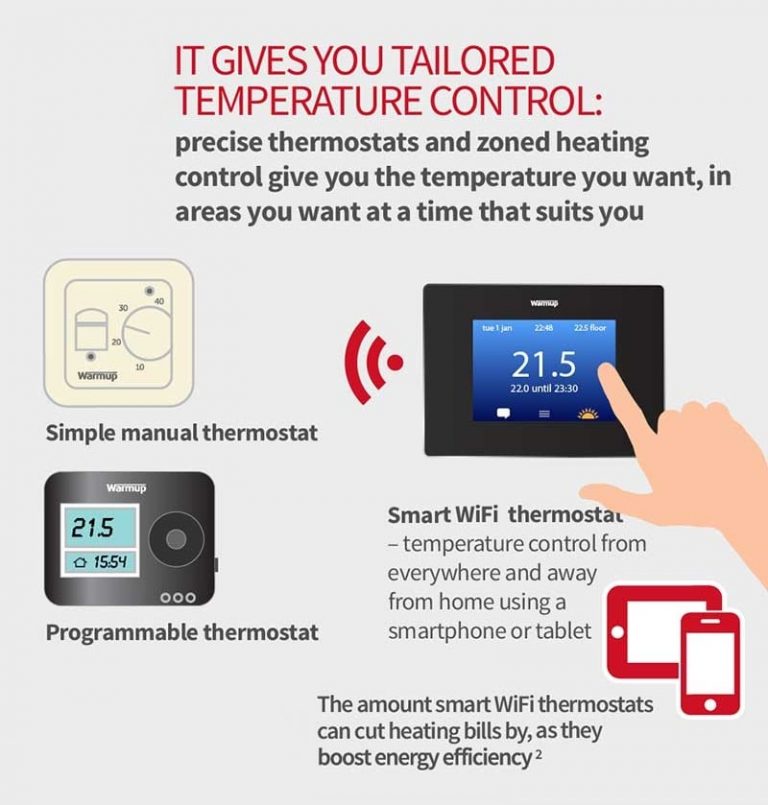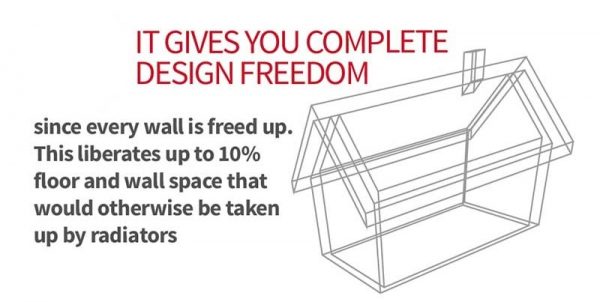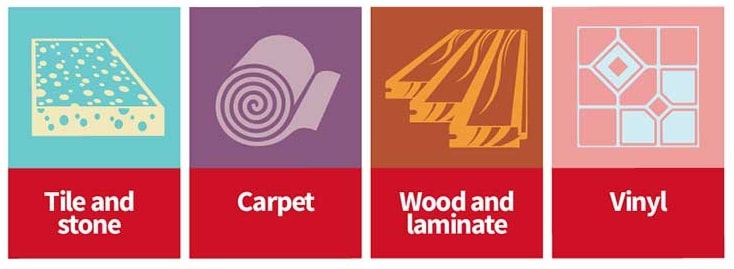(+) Energy Efficient Heating (+) Effortless to Run (+) More Space & Design Freedom (+) Works with all floor coverings (+) Safety and Comfort (+) Ease of Installation
(-) Installation Cost (-) Installation Time (-) Floor Height Issue

Pros of Radiant Floor Heating
1. Energy Efficient Heating
There are two types of radiant floor heating, electric and water-based systems. Both provide heating in a room from the floor up for consistent, efficient warmth. Warm water systems run hot water through pipes to create heat, whereas electric underfloor heating heats wiring beneath the floor to generate heat.
Traditional radiators need to be heated to a high temperature (between 149-167 degrees Fahrenheit / 65-75 degrees Celsius) in order to heat up a room effectively, whereas floor heating only needs to run at a temperature of 84 degrees Fahrenheit / 29 degrees Celsius or less, depending on the floor finish, in order to warm the room – thereby consuming less energy, and keeping your energy bills far lower.

Furthermore, radiators heat the air nearest them first, which is why rooms heated by radiators are prone to “cold spots”, meaning that the air feels cold in the middle of the room and very hot next to the radiators. This usually results in opening a window above the radiator to bring some fresh air in, and there we go again, letting all that energy paid to warm up the house escape out of the window. Radiant heat provides warmth from the floor up throughout the room without any cold spots or stuffiness in the area being heated.
To summarize, unlike traditional radiators which can make a room feel chilly at times and too hot at other times, underfloor heating does not overheat – instead, it achieves the desired temperature set by you using an on-the-wall thermostat.
Radiant heat provides an average saving of 15% on heating bills thanks to the efficient way it warms a home.
2. Effortless to Run
Once installed, underfloor heating needs virtually no maintenance and comes with a 30 Year Guarantee for total peace of mind. The Warmup heating controllers will ensure that your heating runs in the most efficient manner either automatically with a Smart WiFi Thermostat, or, if you wish, with a programmable thermostat that can be programmed to ensure the heating comes on at certain times, giving you the option to switch it off at night time.

3. More Space & Design Freedom
With radiant floor heating, you’re able to enjoy your whole room without radiators on the walls. Even the most modern radiators take up room on a wall, so imagine the design freedom you have with heated floors – you can decorate the walls as you wish, to really make a statement or simply achieve the minimalist look, whatever your style, and free from having to plan around radiators.

4. Works with all floor coverings
Underfloor heating gives you the freedom to design your home as you wish, making the most of all the wall and floor space. And you’re still free to choose the floor type that you want as floor heating works well with laminate, wood, tile, stone, carpet and more.

5. Safety and Comfort
When you have underfloor heating, you no longer need to worry about sharp edges or hot surfaces of radiators when younger family members are in the house. The heating system is safely tucked out of the way and won’t get too hot to the touch.
Radiant heat is also much better for the air quality in a room since it keeps the air fresh and oxygen-rich. On the other hand, high temperatures caused by radiators increase discomfort and reduce oxygen levels. The thermal circulation from air rising to the ceiling and then back gets all the dust going in circles which will not happen with a floor heating system.

6. Ease of Installation
Underfloor heating is easy to install, especially if you make it part of a build or renovation project. For example, Warmup’s StickyMat solution can be installed as a DIY project as it is simple to lay down with the electric wire being all pre-spaced and readily attached to the mesh, ready to be rolled out in place. Plus, there’s even an added cleaning convenience as keeping the rooms dust-free is easier without the nooks and crannies of radiators.
Cons of Radiant Floor Heating
1. Installation Cost
When estimating the cost of an installation, a safe cost estimation bracket is between $10 to $20 per square foot dependant on the type of system you choose for your home. Installation aside, you will still need to call out a qualified electrician to connect the system to your power supply, this may take a few hours and can cost anything between $200 and $250 dependant on who you choose and where you live.
Therefore, the minimum cost is the electrician and the total labor cost for an electric system anything up from $500 depending on the level of professional work required.
Water-based systems are usually installed during the build phase and incorporated into the construction or renovation project, usually at a cost two or three times that of installing an electric system.
2. Installation Time
As you usually need to apply a self-leveling compound on top of the electric underfloor heating system, you should factor in the time it takes for this to completely dry before the floor covering can be put in place – this is usually a day or two. The water-based underfloor heating takes longer to put in place, although this doesn’t normally matter too much as it tends to be installed as part of a bigger building or renovation project and installation is completed within a week usually.

3. Floor Height Issue
As a guide, floor heating systems increase the floor height in a room by an average of a less than 1/2 inch, depending on the system you choose. Furthermore, you may want to place insulation boards underneath the heating equipment to maximize efficiency potential by ensuring all the heat goes up rather than down. Insulation boards will increase the height a little further, by approximately an inch.
However, if losing height in the room is an issue for you, then Warmup’s StickyMat electric underfloor heating system may be ideal – as it has extremely thin cabling attached to the mesh, as a result of this, it will not significantly raise the floor height.
Summary: Is Underfloor Heating Worth It?
Underfloor heating is an easy and energy efficient way to warm your home and to keep your toes cozy. Although the cost of installing radiant heating is higher than the installation cost of traditional radiators, there are various options available to suit your budget and it’s worth keeping in mind that underfloor heating provides substantial cost savings on your energy bills in the longer term.
When remodeling your bathroom, radiant floor heating is especially worth thinking about. You will save a lot on the labor cost if the flooring is being lifted up and changed anyway. The comfort and the cost savings of running the system on your heating bills will work out to your advantage in a longer run.
> ESTIMATE your underfloor heating RUNNING COST HERE
> VIEW the Warmup electric underfloor heating PRODUCT RANGE HERE
Heated Floors
Floor heating is the modern heating solution – creating the perfect temperature, making you feel warm and comfortable from the moment you enter the room.
